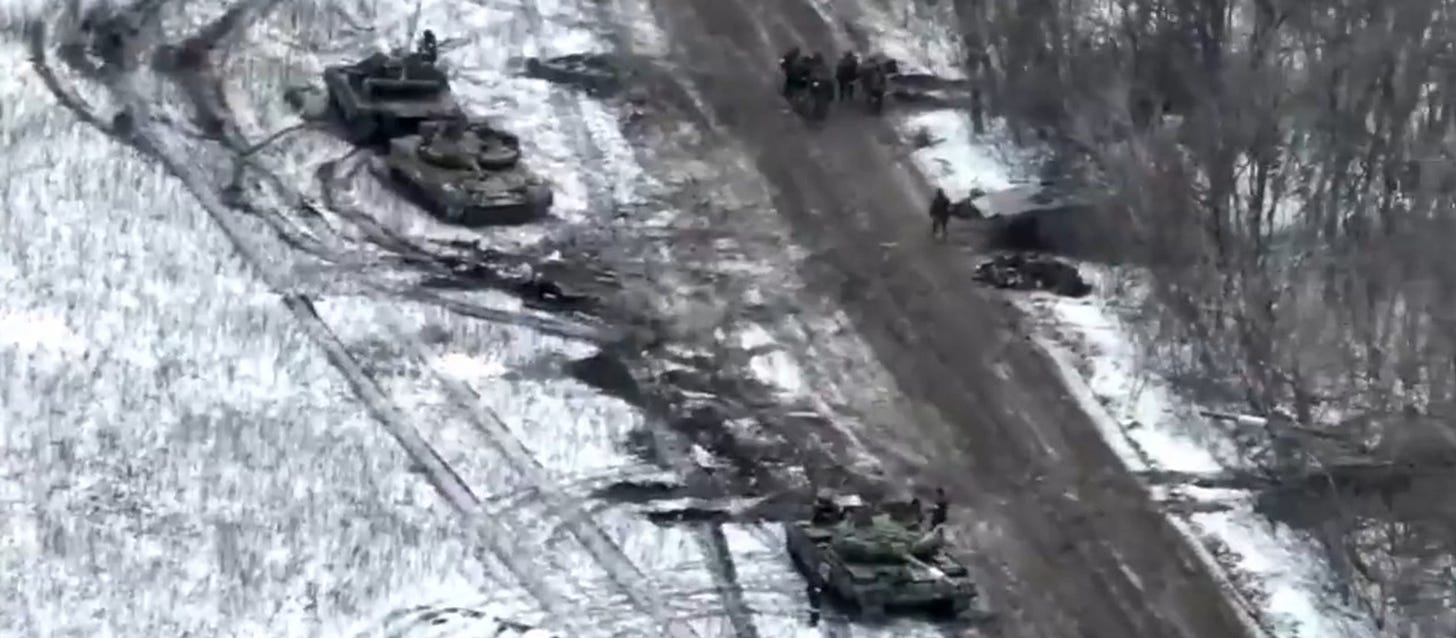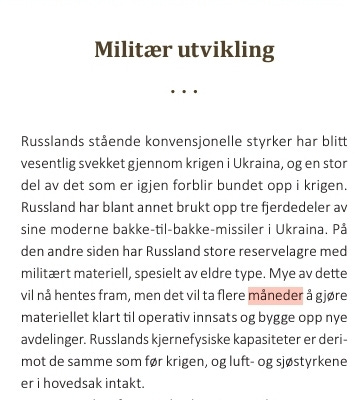What to expect for the coming months? Opinions now vary from expectations of a larger Russian offensive to coincidence with the anniversary of the invasion, to that what we are seeing is the limit of current Russian capabilities that soon will culminate.
Future Ukrainian offensive operations is also a topic of many discussions.
My purpose with this article is to share some thoughts and look at some factors that will influence operations this spring and into the summer.
Russian operations so far in 2023
What has been ongoing the past month or so can be interpreted as an underwhelming Russian winter offensive.
It is also possible to see a Russian rationale behind this, despite the high casualties and the limited progress that has been made so far.


Conquering all of Luhansk and Donetsk Oblasts would be a political victory for Russia, especially on the home front, but in determining the outcome of the war, not much would change. Also, achieving this within any reasonable time-frame seems unlikely since the Russian forces are unlikely to be able to exploit any breakthrough.
The continued pressure around Vuhledar does make sense, as getting the Melitopol - Donetsk railway operational would greatly improve logistics in the south, both for defensive and offensive operations. That the Russians are able to accomplish this is another question and chances right now appear slim of this happening.


Russia's ability to conduct a larger, more mobile offensive at this stage is also doubtful. I had anticipated that any attempt to push towards Kupyansk, on the northern end of the line, would be supported by an attack south from Belgorod to outflank Ukrainian positions. This hasn't happened and I have seen no indications that such a grouping is being created either.
In addition to the current offensive operations, the Russians are also continuing to expand their extensive defensive lines, especially in the south. This indicates that they at some point expect Ukrainian offensives in this direction.
Russia: Attrition, logistics, mobilization and new fronts
What we are currently seeing is a war of attrition, where logistics, force regeneration, mobilization potential, industrial capacity and the rate of attrition between the two sides largely determines the outcome.
For all it's faults, the Russian mobilization in October managed to stabilize the lines, significantly increase Russian force density and enable the manpower intensive operations we are currently seeing. Consuming manpower at a high rate over time is risky and could put Russia in a similar position as last year if they don't conduct new waves of mobilization.
There has been many rumors and indicators that another wave of mobilization is coming, but a new large call-ups has likely yet not been initiated. The further the Kremlin postpones this decision, the greater the risks of significant problems from the summer onwards becomes.
Mobilization of the economy and withdrawing and reconditioning equipment from storage also seems to go slower and take longer than I expected. Despite this, I would caution against underestimating Russias mobilization potential and their ability to sustain a long war.
Sometime ago, it was a widely held assessment that some 100 000 - 150 000 mobilized personell remained training in Russia, and thus constituted a strategic reserve. By now however, some of these has likely been deployed to the frontlines, so estimating current Russian available reserves is hefted with uncertainty.
Are there enough forces available to expand operations beyond the current frontline? While I won't rule such a possibility out, I am now doubtful, especially without redeployment of units away from the active front. In fact, the opposite seems to be happening with units rotating in after training in Belarus. There are currently no Russian groupings outside the active frontline that are large enough for any meaningful offensive operations.
For the Russians to have any hope of success in expanding operations, new waves of mobilization is likely needed, with more new units raised and given at least rudimentary training. The timeframe for a large scale Russian offensive, beyond what we are seeing now, could then have to be pushed forward to summer/early fall and a lot could happen in the meantime.
Munitions stockpiles is also an important factor that potentially could limit Russian operations. While much has been written and said on Russian ammunition shortages, there seems to be enough for the current operations. Uncertainty regarding stockpiles, production, foreign suppliers and consumption makes it hard to make good assessments on this relying only on open sources.
Ukraine: Attrition, logistics and Western support
While determined Ukrainian defensive operations has managed to blunt the current Russian offensives, this comes at a cost. Tight OPSEC precludes detailed insight into Ukrainian losses but I assess they have not been insignificant. It is also possible some reserves have had to be committed to hold the line.
The Ukrainians are consuming vast amounts of munitions, especially for artillery, far outstripping current Western production. This could turn into an issue for future Ukrainian offensives, as artillery ammunition availability has been the determining factor in both sides offensive potential in this war. Western production has been way too low for an industrial scale war and ramping up production takes time. A “shell crisis” has been avoided so far, but Ukraine is not out of the woods on this yet. Availability of Soviet caliber munitions also remains an important factor.
The Western decisions to finally donate IFVs and MBTs is important for the long run, but I would caution against overestimating the impact the recently announced donations will have on the battlefield in the timeframe covered here, due to low numbers.
Of modern MBTs we are looking at a couple of battalions of Leopard 2s, a battalion of M1s and company of Challenger 2s. The Leopard 1s add more numbers but the timeline is also longer. IFV deliveries are more numerous but still measures in battalions, not brigades. To represent a significant increase in offensive potential, I belive AFV deliveries need to approach the equivalent of atleast 3 brigades, and go forward from there. There will be losses needing replacements too.
Being able to sustain and maintain the new equipment in the field also vital. The Ukrainians will likely manage, but it's important not to underestimate this aspect, especially since many different types of AFVs are provided in relatively low numbers.
What could have immediate impact on the battlefield would be the delivery of long range strike systems. Giving Ukraine the ability to strike Russian logistics beyond current reach could put a significant strain on the Russian logistical system. The further south and away from Russia proper, the greater this impact could be, especially in hampering offensive operations. Unfortunately, Western countries still lack the political will to take this step and the US seems to have found new excuses.
Sustaining Ukrainian air-defences is also important. If the Russian strike campaign results in depleted Ukrainian SAM stockpiles, this could enable a more serious effort by the Russian Air Force, in addition to heavier damage to the critical infrastructure. There are also reports and rumors indicating that a increase in VKS operations could be looming, even though Ukrainian air defences remains potent.
Future Ukrainian offensives will likely come but are more likely towards late spring/early summer than in the short term, in part due to waiting for Western supplied AFVs to enter service. It is difficult to estimate what coming Ukrainian offensives can accomplish and overestimating what can be achieved isn't helpful. Increased Russian force density and defensive preparations will likely make coming Ukrainian offensives look more like the hard slog of Kherson than the rapid thrust in Kharkiv, though uncertainty exists in this regard too.
Russian war-aims: Political objectives vs military reality
There are no reasons to believe that the Russian leadership has revised their original war aims. However, with the way the Russians are running the war, they are unlikely to achieve these, creating a growing void between political objectives and military capabilities.
This is the main reason why I believe one needs to keep an open mind when discussing future Russian operations. Continuing as they do now, expending manpower at a high rate for minimal gains, won't win the war for Russia, only prolong it. Sooner or later Moscow may come to this conclusion as well and actually try something new. To capture additional territory, they need to stretch Ukrainian forces and this would, in my opinion, require new fronts. Also, despite how unrealistic it may seem to many, Kyiv remains the grand prize and political will could override a sensible approach.
To open new fronts and be successful, Russian needs a larger army and this puts them in a bind. Either they have to conduct further mobilization, and risk political upheaval and domestic instability, or Russian attrition will again likely enable Ukrainian maneuver.
There are no easy solutions for Russia and the longer they wait with taking the hard decisions, the worse their position gets. Again, don't underestimate Russia because of overestimating them a year ago. Going forward, we are sailing in uncharted waters.
Summing up
What I have tried to do here is to discuss some factors that will influence the course of the war this spring. What are the Russians actually capable of and can Ukraine conduct serious spring/summer offensive later on? At the current time I find it difficult to draw hard conclusions on these questions and my current mood is leaning towards wait and see.
Events may overtake much of what I have written here. What is highly likely though is that there is much brutal and heavy fighting still ahead. Russia is unlikely to back down and Ukrainian success hinges on continued and increasing Western support and industrial capacity.
For strategic planning purposes, the planning assumption must remain a long war, well into 2024 and beyond.
Regards
The Lookout









What are the numbers of Bradley's marders and other we specifically need to see to expect a successful offensive?
Wow, glad I'm moving most of my own analysis of the war to Substack. This is 1000% better than almost anything I've found on Medium.
Also good to see I'm not entirely alone in my evaluation of Russia's need to open a new front, if it can. Starting to look like it's too late for this to play out, but in theory Moscow might just be nutty enough to play 'seven days to the river Dnipro' west of Kharkiv with whatever strategic reserve has been built up.
But, it is beginning to look like Putin may instead be planning a forever war rather than risk a 'one last big push' scenario that could lead to thousands of prisoners and renewed pressure from hard right nationalists to do some nuclear signaling, maybe after Enerhodar has a minor meltdown Russia blames on Kyiv.
Regardless, dear western leaders: stop holding back. Open the arsenals. Worry about China later.